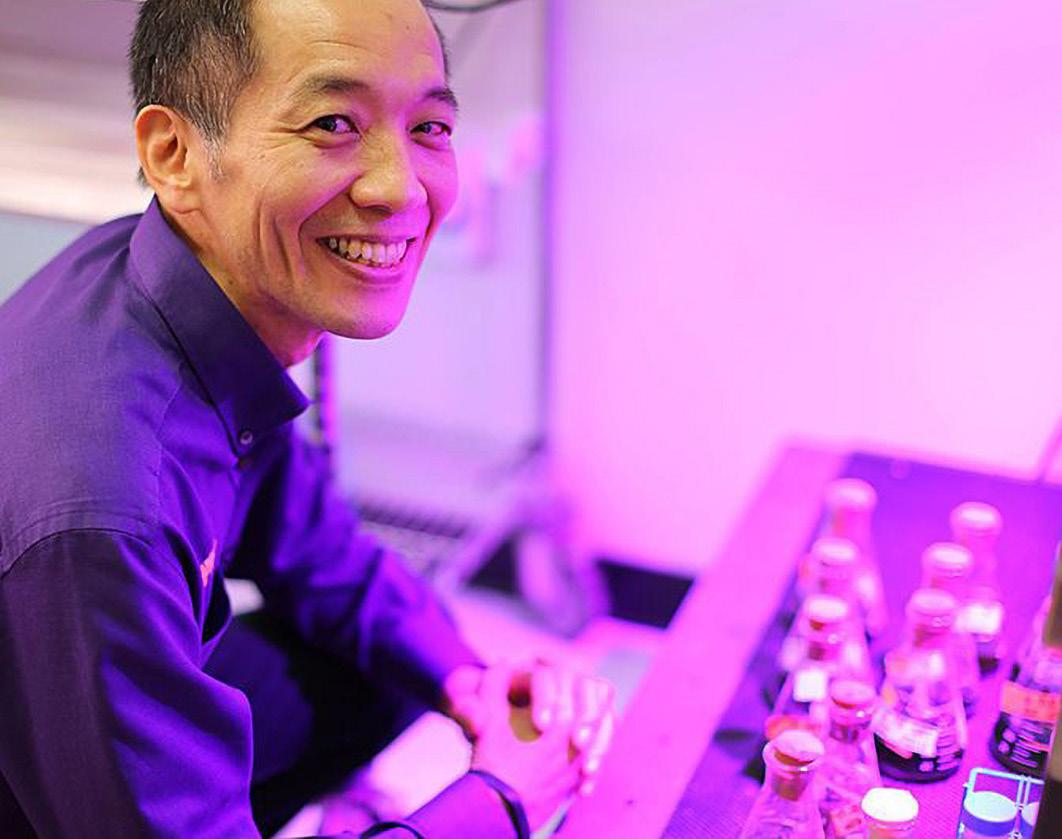
5 minute read
Our Louisiana
TOTAL ECONOMIC IMPACT OF LSU ON LOUISIANA: $5.1 BILLION
LSU FLAGSHIP CAMPUS ECONOMIC IMPACT
$2.7 BILLION
$815 MILLION IN EARNINGS
18,769 JOBS ACROSS THE STATE OF LOUISIANAA
LSU IMPACT ON SCIENTIFIC RESEARCH AND DEVELOPMENT SERVICES: $57.4 MILLION
Source: The Economic Impact of LSU on Louisiana (2017), LSU E.J. Ourso College of Business Economics & Policy Research Group
Louisiana Impact
LSU scientists make our state stronger
ECONOMIC IMPACT
New insights into oyster farming
Morgan Kelly, assistant professor in LSU’s Department of Biological Sciences, is a marine biologist who studies how oysters adapt to changes in their environment.

Morgan Kelly, marine biologist and assistant professor in the Department of Biological Sciences at LSU, collecting oysters.
Oysters play an important role in our living ecosystem by filtering and cleaning water, which positively impacts other species. Oyster beds also help stabilize the shoreline preventing coastal erosion and land loss. Not to mention, Louisiana’s oyster fishery is a roughly $85 million industry, making it the largest in the country. Kelly studies how warming temperatures in the Gulf of Mexico and a rise in fresh water from heavy rainfall and freshwater diversions impact oysters. She and her graduate students conduct research at the Michael C. Voisin Oyster Hatchery on Grand Isle, La., as well as in the lab at LSU.
“In our research, we put oysters from different populations out into the environment to study how they react to various levels of salinity and temperature,” said Kelly. “We want to know which oyster populations can best adapt genetically to a changing environment.”
Morgan identifies the strains of oysters that can survive best in low saline conditions. She hopes managers will be able to use those strains to repopulate oyster breeding grounds where salinity levels fluctuate most.
ADVANCING K-12 EDUCATION
Chemistry inspiration
The LSU College of Science leads the way in math and science education. From training teachers across Louisiana, to developing K-12 curriculum, we support learning for all Louisiana youth.
For more than 20 years, LSU’s ChemDemo program has brought more than 150,000 LSU undergraduates to over 7,000 classrooms in Louisiana, Texas, Mississippi, Alabama and Florida.
ChemDemo uses safe, fun, hands-on demonstrations to expose K-12 students to a variety of thematic concepts in chemistry.
George Stanley, Cyril and Tutta Vetter Louisiana Fund Alumni Professor of Chemistry, started the program in 1997 with support from corporations such as Albermarle, ExxonMobil and Dow Chemical. ChemDemo undergraduates have interacted with more than 182,000 K-12 students in its 22-year history, which makes it the largest K-12 service learning activity in the nation.
SAVING OUR COAST
Understanding land loss and its impact
The Mississippi River Delta and coastal Louisiana are disappearing at an astonishing rate. Researchers report losses as much as a football field of wetlands every 100 minutes. The kicker—more than 80 percent of the nation’s coastal land loss occurs in Louisiana. Researchers predict that by 2040, Louisiana will have lost more than one million acres of coastal wetlands triggering a 30 percent decline in recreational fisheries harvest and impacting nearly 50,000 jobs in the fishing industry.
LSU researchers are working to help us better understand the causes of land loss and to explore ways to sustainably conserve our coastlines. Sam Bentley, Billy and Ann Harrison Chair in the Department of Geology & Geophysics and vice president of LSU’s Office or Research and Economic Development, is documenting the land loss along the Mississippi River Delta by collecting sediment cores.
Bentley uses a three-inch-diameter PVC pipe affixed to the end of a pole to collect layers of sediment, or a core.
“I refer to some of our work as Home Depot oceanography,” Bentley said. “If you put ‘marine supplies’ or ‘science’ in front of anything you want to buy, then you’re going to have to add an extra zero to the cost, or maybe three (extra zeroes).”
To collect sediment, Bentley and his team travel by boat to a specifically identified location in the river and firmly insert the pipe into the bottom of the river floor. What he receives is a collection of mud and sand that are piled up on top of the other. In what would appear to be just layers of dirt to most, Bentley sees a timeline of natural and man-made occurrences that have impacted the coast in that area.
The combination of sea level rise and man-made obstructions to the natural flow of sediment (to create deltas) collectively has a negative impact upon Louisiana’s coastline.
“Conditions are dire for much of the coastal region of the Mississippi River Delta and our children’s children will see a coastal landscape that we might not recognize,” Bentley said.
MAKING MARDI GRAS MORE GREEN

Professor of Biological Sciences Naohiro Kato has created biodegradable Mardi Gras beads and dabloons.
A sustainable alternative to traditional throws
After the revelry of Mardi Gras, thousands of pounds of plastic beads enter our environment each year with most of the throws ending up in the landfill. LSU Professor of Biological Sciences Naohiro Kato believes that we can do a better job of making our annual celebration more sustainable and environment friendly. Kato has developed biodegradable Mardi Gras beads and dabloons.
One of Kato’s students at LSU accidently discovered the basic ingredients Kato has refined to produce the biodegradable beads.

FUN FACT: The beads were created after one of his students “partied too hard” and forgot to end a lab experiment spinning cycle on time, which resulted in a gooey, oily mess that gave Kato the brilliant idea to create biodegradable beads.
“My student was supposed to come into the lab three nights in a row to move our test tube samples for algae from the centrifuge to the freezer, but one night he forgot,” Kato said.
The next morning, Kato found a large glob of green algae accumulating oils—one of the ingredients used for bioplastic production—on the bottom of the centrifuge.
Kato has further refined the process for creating the beads and has patent applications pending for various formulations and methods of making the biodegradable beads that could help prevent tens of thousands of pounds of plastic Mardi Gras beads from entering the environment each year. Kato is also in discussion with a nutraceutical company and awaiting a contract to begin production of biodegradable Mardi Gras beads.
Visit lsuscienceblog.com Naohiro Kato shares “10 Things You Didn’t Know about Mardi Gras Beads...that Biodegrade!”










